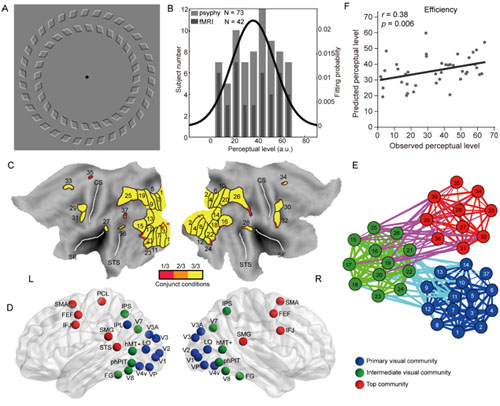Time:2016-11-24
A recent study published in Cerebral Cortex demonstrated that dynamic network communication in human brain visual cortex predicts perceptual variability of Pinna illusion. This work was performed by researchers in Dr. WANGZheng’s lab, in close collaboration with Dr. GU Yong and Dr. WANG Wei at the Institute of Neuroscience, Shanghai Institutes for Biological Sciences, Chinese Academy of Sciences. Ithas tested the hypothesis that an interplay between communities within visual stimulus-evoked network architecture may contribute to individual differences in the perception of a prominent visual illusory motion. This work may pave a new avenue of investigation into other perceptual and cognitive functions through exploration of the relationship between individual variability and network dynamics.
Individual differences in visual perception are ubiquitous and nuanced. In contrast to the percept of a real object, illusory perception is remarkably different between individuals.Pinna illusion is the first visual illusion showing a rotating motion effect, as shown in Figure A.When the observer is moving her/his head towards (backwards)the figure with the gaze fixed on the center dot, the inner ring appears to rotate clockwise (counter-clockwise) and the outer ring counter-clockwise (clockwise), although both rings are actually static. After evaluating the perceptual level of 73 volunteers to the Pinna illusion based on their psychophysical results, the researchers found that these volunteers showed dramatically variable perceptual experience to the Pinna illusion, i.e., reporting either much faster or rather slower illusory rotation speeds. The perceptual levels to the Pinna illusion followed a normal distribution (Figure B).They determined to unravel the underlying neural mechanisms of perceptual variability with fMRI.
A group-level brain activation map evoked by the Pinna illusion was obtained, which contained a total of 37 brain regions (Figure C).A functional connectivity network was then constructed on the basis of region-wise correlation (Figure E). Graph theoretical analysis revealed that this connectomic network could be decomposed into three subnetworks or moduleswith using a module detection algorithm: the primary visual moduleprimarily occupied low-level visual areas, the intermediate visual module was mainly composed of high-level visual areas and the top module included some frontal-parietal areas (Figure D and E).By exploring the relationship between intra- or inter-subnetwork communication and perceptual level to Pinna illusion, investigators found that the higher efficiency the communication between primary and intermediate visual modules is, the weaker the perception to Pinna illusion is, i.e. one would perceivea real physical world.This robust relation could even be used to predict individual’s perceptual level to the Pinna illusion (Figure F), which was also condition specific.
This work entitled “Dynamic Network Communication in the Human Functional Connectome Predicts Perceptual Variability in Visual Illusion” was published online in Cerebral Cortex on November 22, 2016. It was completed by graduate student WANG Zhiwei under the supervision of Dr. WANG Zheng, and supported by Strategic Priority Research Program (B) of the Chinese Academy of Sciences (XDB02050000) and National Natural Science Foundation of China Grant 81571300 .

Figure legend: (A) Pinna illusion, (B)Perceptual levels to Pinna illusion in the human population observed a normal distribution,(C)Brain activation map of Pinna illusion, (D) Topological show of hierarchical modular organization.(E) Modular layout of Pinnaillusion-evoked brain network, (F)Communication between two visual modules predictsvaried perception to Pinna illusion.
 附件下载:
附件下载: